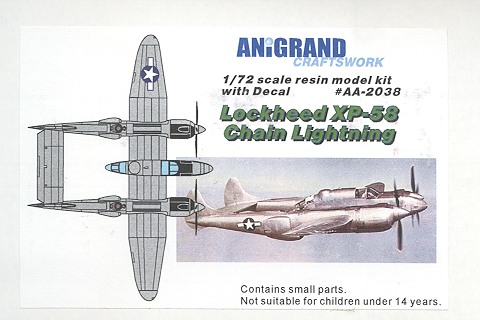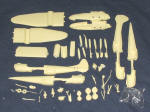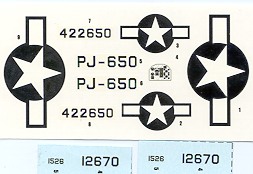
| KIT: | Anigrand 1/72 XP-58 'Chain Lightning' |
| KIT #: | AA-2038 |
| PRICE: | $49.00 from Nostalgic Plastic |
| DECALS: | One option |
| REVIEWER: | Scott Van Aken |
| NOTES: | Short run resin with vacuformed transparencies |

| HISTORY |
One of the little known situations about the American Aviation industry during World War II is their near total inability to develop and get into production an aircraft designed during the conflict. All the planes we know so well; the P-39, F4U, P-51, F6F and so on were all initially developed before 1942 when America entered the war. The exceptions are few and include the B-29 and the P-61, with the P-61 being the only fighter to make it into battle.
So what was the problem? Well, there was a lot of favoritism involved where aircraft that were never going to show promise had millions of dollars tossed at them with no real results. Same with experimental liquid cooled engines. None of the ones under development made it into full production. The other is that the Army in particular, kept changing its mind on exactly what it wanted out of an aircraft. As the war situation changed, so did the specs for experimental airplanes. This could be seen in the prolonged development of the Curtiss P-60 series.
It was also part of the reason the Lockheed's XP-58 never made it past a single prototype. They couldn't make up their mind on what the plane should be. Was it a long range escort fighter, a bomber destroyer, a twin seat attack aircraft... No one was sure. Then there was the situation with power plants. The initial Continental XV-1430s would make the plane underpowered so it was decided to go with Pratt and Whitney XH-2600s, but that engine's development was halted so they went with the Wright XR-2160s; another experimental engine.
This 42 cylinder liquid cooled engine showed great promise but was highly complex and quite heavy, increasing the weight of the total aircraft. Then the flail-ex about armament and turrets and things were going nowhere fast. Lockheed suggested freezing the design and building one airframe as a test bed so with the lack of availability of the Wright XR-2160s, a pair of Allison V-3420s were installed and the aircraft finally took to the air in June of 1944, four years after the design was first started.
A total of 25 flights was made in an aircraft that was too heavy, too slow and for which there was no mission. It was transferred for use as a ground instruction airframe in early 1945. Thanks to Army mismanagement and engine problems (something Lockheed had no control over) 2.4 million 1944 dollars were wasted on a program that resulted in nothing.
| THE KIT |
 Somewhat
like the actual aircraft, Anigrand's kit is a bit on the complex side.
There are a lot of bits and pieces in this large, twin-boom aircraft. The
overall molding is pretty much what one comes to expect from an Anigrand
kit. There are somewhat large engraved panel lines of a uniform depth. Some
indication of air bubbles are found, mostly on the trailing edges of parts
and inside a few cavities, like the turbocharger intercooler exhaust, where
they will be difficult to fill. I also found them on the booms just forward
of where the wing slots in place. Most of these can simply be opened up,
filled with super glue, and sanded. There were a few sink areas as well
that can be easily filled with putty and sanded smooth. Be sure to check
the prop blades as I found a couple that were a bit rough.
Somewhat
like the actual aircraft, Anigrand's kit is a bit on the complex side.
There are a lot of bits and pieces in this large, twin-boom aircraft. The
overall molding is pretty much what one comes to expect from an Anigrand
kit. There are somewhat large engraved panel lines of a uniform depth. Some
indication of air bubbles are found, mostly on the trailing edges of parts
and inside a few cavities, like the turbocharger intercooler exhaust, where
they will be difficult to fill. I also found them on the booms just forward
of where the wing slots in place. Most of these can simply be opened up,
filled with super glue, and sanded. There were a few sink areas as well
that can be easily filled with putty and sanded smooth. Be sure to check
the prop blades as I found a couple that were a bit rough.
The cockpit is pretty basic with but a
seat and control stick provided. There is also a seat and sight (as in a
P-61) for the rear. If your kit comes with turrets one must fill in the gun
slots as the lone prototype was not armed. They are designed to be able to
rotate. My example did not include these parts, but an e-mail to the
importer showed another kit with two sets so I'll have these for the build. Other bits included are drop tank
pylons, and a nose cannon (not used on prototype).. You'll also have to
find a place to pack in the weight as these types of aircraft are notorious
tail-sitters. Fortunately, the main gear looks pretty sturdy, but the nose
gear is rather fragile looking and may deform under the weight. You may
want to consider replacing thi s
with one made mostly from metal tubing. The vacuformed canopies are a bit
distorted and the frame lines are unclear and will be difficult to properly
mask. But you've heard most of this before.
s
with one made mostly from metal tubing. The vacuformed canopies are a bit
distorted and the frame lines are unclear and will be difficult to properly
mask. But you've heard most of this before.
The instructions are typical of Anigrand with a three-view and painting guide on one side with a history, photo and exploded view on the other side. Thanks to the general simplicity of the kit (as in not having a hoard of fiddly bits and inserts for different variants), this type of construction drawing is quite adequate. The XP-58 does have a few references available and you can find more info on the web by doing a search. The decals seem to come from the XP-59 kit with smaller separate sheets for the serial numbers. Actually, all this plane had were insignia and serials. Nothing fancy at all.
| CONCLUSIONS |
Anigrand adds yet another interesting subject to their line of resin kits. In the last few years, more US prototypes in 1/72 scale have been produced by this company than I've seen in the last 15 years. Their kits are not only interesting, but not that difficult to build once you have done one or two. They are something that the intermediate modeler will have no real trouble with and the experienced modeler is given a basis for a super detailing job!
June 2005
| REFERENCES |
Lockheed Aircraft since 1913, Rene J Francillon, Naval Institute Press, 1987. ISBN 0-870211-897-2
As a bit of a postscript, Nostalgic Plastic (hyperlink below), now offers replacement canopies and decal sheets for Anigrand kits at $1 each. No more need to send off to Hong Kong if you make a goof and need a replacement bit.
Many thanks to for Nostalgic Plastic the review sample. Get yours direct.
If you would like your product reviewed fairly and quickly by a site that has around 300,000 visitors a month, please contact me or see other details in the Note to Contributors.